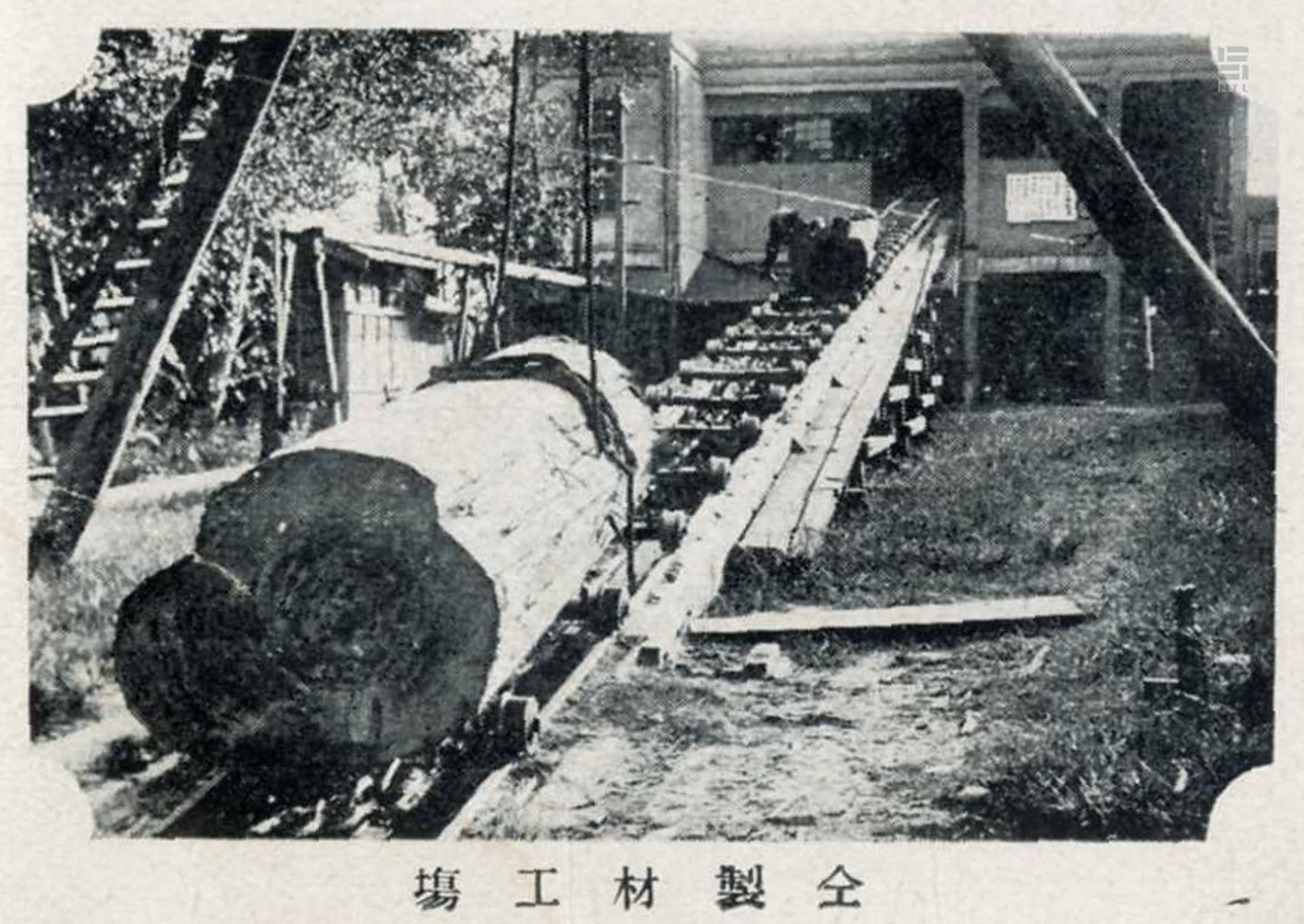木材工廠
為提供使用者有文書軟體選擇的權利,本文件為ODF開放文件格式,建議您安裝免費開源軟體 ([連結])

木材工廠
Lumber Factory
木材工場
1921, 紙本水彩, 18.2×23.5cm
watercolor on paper
紙本水彩
鐵軌、工廠、煙囪、纜線,巨大的水泥建築與轟隆作響的機械──號稱「東洋第一」的嘉義製材場集合了種種現代化的奇觀。1920年代初期,整個嘉義以木材產業為核心,逐漸發展成繁榮的大都市。城北近郊的製材場,則是促成這一切改變的動力來源。
Railroad tracks, factory buildings, smokestacks, steel cables, colossal cement structures, and loudly whirring machinery—all of these modern marvels comprised Chiayi’s lumber factory, often referred to as “East Asia’s Finest.” By the early 1920s, Chiayi had grown into a thriving metropolis after substantial investment in its lumber industry. The central force behind this great transformation was none other than the lumber factory on the town’s northern outskirts.
レールや工場、煙突、ワイヤロープ、コンクリート製の巨大な建物と轟音を響かせる機械──「東洋一」と謳われた嘉義の製材場には、近代化を象徴するような奇観の数々が集結していました。1920年代初頭は嘉義全体が林業を主要産業として発展し、しだいに豊かな大都市へと成長を遂げたのです。嘉義近郊の製材場はその発展を促す動力源でした。
陳澄波的少年時代,嘉義經歷了巨大的改變。這幅水彩畫,或許可以看作一種歷史的見證。
This watercolor painting bears witness to the tremendous changes which Chiayi underwent during Chen Cheng-po’s youth.
陳澄波の少年時代に嘉義は大きく変化しました。この水彩画は歴史を物語る証の一つと見なせるでしょう。

1.製材工廠
Sawmill
製材工場
三層樓的鋼筋水泥建築是落成於1914年的製材室。杉池裡熟成的原木循著輸送帶被拉進二樓裁製為木料,再經過乾燥等程序便能轉售民間業者。這幢建物毀於1941年的地震,總督府遂興建第二代製材室,在戰爭期間繼續工廠的運作。
A three-story, steel-reinforced concrete structure, the sawmill was completed in 1914. Logs ready for sawing after their soak in the “Chinese fir pond” were brought by conveyor belt to the second floor, where they were split into lumber. After being dried and processed, the lumber was ready for sale to private merchants. Unfortunately, the original sawmill was destroyed in 1941 by an earthquake, but it was reconstructed under the direction of the Taiwan Governor-General’s Office, and factory operations continued throughout the war.
3階建ての鉄筋コンクリートの建物は1914年に竣工した製材室です。杉池で熟成された原木は搬送用のローラーコンベアで2階に運ばれ、裁断して木材にし、乾燥などの工程を経てから民間業者に売り渡されました。この建物は1941年に発生した地震で損壊してしまったため、総督府により二代目の製材室が建造され、戦時中も製材工場として稼動し続けました。

製材廠的輸送帶。出處:嘉義街役場,《大嘉義》(大阪市:英進舍工場印刷,1929)。
The factory’s conveyor belt. Source: Chiayi Town Hall, Big Chiayi (Osaka: Eishin Publishing House, 1929).
製材工場のローラーコンベア。出典:嘉義街役場,『大嘉義』(大阪市:英進舍工場印刷,1929)。
國立臺灣圖書館授權
2.動力室
Boiler room
動力室
1913年興建的動力室,是嘉義第一座火力發電廠與鋼筋混凝土建築。除了為製材所內的機械供電,它也將電力輸出給周邊的北門地區。1931年,製材所內的電力改由嘉義電燈株式會社提供,動力室更改為配電所,發電工作就此結束。
Constructed in 1913, the boiler room was Chiayi’s first reinforced concrete structure and coal- or wood-fired power plant. The boiler produced more than enough electricity to power all factory machinery, so surplus electricity was routed to the nearby Beimen neighborhood. In 1931, after the Chiayi Lighting Corporation began supplying electricity to the lumber factory, the boiler room was no longer used for power generation. Instead, it was converted into a power distribution center.
1913年に建造された動力室は、嘉義初の火力発電所と鉄筋コンクリート製の建築物でした。この動力室は製材所の機械だけでなく、周辺の北門地区にも電力を供給していました。1931年から製材所で使用される電力は嘉義電灯株式会社から供給されることになり、動力室は配電所とされ、発電所としての役目を終えました。
3.鋸屑室
Sawdust storeroom
鋸屑室
製材過程所產生的木屑,被集中貯存於此地,其後又被送到動力室,成為發電的燃料來源。木屑的運送,則透過畫面當中連結於鋸屑室的兩條輸送帶來完成。今天,鋸屑室只餘下半部的RC構造基座,上半部的木造倉庫則已不存。
The sawdust produced during the milling process was collected and stored in this room. It was then transported to the boiler room by two conveyor belts, as pictured in the painting, and fed into the boiler to be used as fuel to generate electricity. Today, the wooden warehouse no longer stands. All that remains of the sawdust storeroom is its reinforced concrete structural foundation.
製材の工程中に出た木屑は鋸屑室に貯蔵されてから、発電の燃料として動力室に搬送されました。木屑の搬送には、画面手前に見える、鋸屑室に続く2本のローラーコンベアが使われました。現在は鋸屑室の下半分ほど、RC構造の基礎が残されているのみで、その上にあった木造倉庫はもうありません。
4.煙囪
Smokestack
煙突
動力室裡的蒸汽鍋爐轟隆隆地運轉,灰黑色煙霧竄進排煙道,透過120呎長的鐵製煙囪,終於向高空排散。高聳的煙囪曾是早期嘉義的現代化奇景,從城鎮各處一望可見。1965年,煙囪因地震傾倒,僅存排煙道部分遺跡仍保存迄今。
In the boiler room, the steam generator noisily churned away as grayish-black smoke was drawn into the exhaust duct, piped up the 120-foot-tall iron smokestack, and finally discharged into the sky high above the factory. In early Chiayi, the tall smokestack was a spectacular symbol of progress, visible from all points around town. However, this landmark was destroyed by a 1965 earthquake; a portion of the flue is the only remaining vestige.
動力室の蒸気ボイラが轟音を立てて稼動すると、灰黒色の煙が排気ダクトに流れ込み、120フィートある鉄製の煙突から煙が吐き出されます。高々と聳える煙突は、早期の嘉義の近代化を示す奇景の一つで、町の至るところからその姿を目にすることができました。この煙突は1965年に地震で倒壊してしまい、現在は排気ダクトの一部が残されているのみです。
5.天車
Overhead crane
天井クレーン(起重機)
高大的三角形鋼架是購自美國Allis-Chalmers公司的天車(起重機),也是嘉義製材廠內最具代表性的景物。分立於貯木池邊的兩座天車循著軌道平行移動,天車的頂端以鐵索相連,吊鉤則在鐵索上來回運動,執行木材的搬運工作。
The image of this monumental overhead crane came to represent the factory more than any other. Manufactured by the US company Allis-Chalmers, the “sky wagon” (the crane) was composed of a pair of triangular steel-frame towers positioned on opposite sides of the log pond. The towers, set on tracks, could be moved up and down the pond’s banks. The tops of the towers were connected by iron cables from which the crane’s hook block was suspended, and the hook could be moved back and forth over the pond to pick up and transport logs.
高大な三角形の骨組みは米国Allis-Chalmers社のクレーン(起重機)で、嘉義製材工場を代表する眺めの一つです。貯木池の傍らに立つ2台のクレーンは軌道に沿って平行移動します。クレーンの上端はワイヤロープで繋がっており、このワイヤロープ上を往復するフックで木材を搬送しました。
6.乾燥室
Drying room
乾燥室
造型宛如蝸牛的長方型建築是1914年建造的乾燥室,也是臺灣現存最早的蒸氣乾燥設備。室內裝設的蒸汽鐵管送出熱風,木材在軌道上緩緩向出口滑動,達到乾燥與調節水分的目的。多餘的水氣,則透過屋頂的兩根煙囪向外排散。
The rectangular, “snail-shaped” drying room was constructed in 1914 and housed Taiwan’s earliest steam-drying equipment. In order to reduce the moisture content of the wood and dry the logs, iron hoses blasted hot air in the direction of the logs as they were slowly carried on a conveyor belt towards the exit. Water vapor exited the room through two antenna-like gas flues above the roof.
カタツムリのような長方形の建物は1914年に建てられた乾燥室で、現存する台湾最早期の蒸気乾燥設備です。室内に設置された鉄製の蒸気管から熱風を送り、軌道上の木材を出口に向かってゆっくりと移動させながら、乾燥と水分の調節を行います。余分な水気は屋根にある2本の煙突から外に排出されます。
7.背面的文字
The writing on the back of the painting
裏面の文字
1921年8月,結束訪歐行程的裕仁太子正在返日途中,他所搭乘的輪船通過臺灣海峽那天,也是這件水彩畫完成的日子,陳澄波特別在背面留下筆記,以紀念此事。日治時期,皇室成員的行動備受人民矚目,即便在臺灣也不例外。
The movements of Japan’s imperial family attracted much attention within the country and even in colonial Taiwan. In August of 1921, the Crown Prince Hirohito was homeward bound following a tour of continental Europe. Since Chen completed this watercolor on the day that the Crown Prince’s ship passed through the Taiwan Strait, he made note of the special occasion on the back of the painting.
1921年8月、欧州各国訪問を終えられて、帰国の途についた裕仁皇太子殿下の船が台湾海峡を通過したその日は、この水彩画が完成した日でもありました。陳澄波はこれを記念して、絵の裏にそのことを書き留めています。日本統治時代、皇族方の動向は常に人々の耳目を集めていましたが、台湾も例外ではありませんでした。
WCP4_10-002.jpg)
畫作背面有兩段筆記文字,其內容分別翻譯如下:
The back of the painting bears two passages which are translated as follows:
作品の裏面に二つに分けて書かれた文がある。以下に中国語訳を附す。
東宮殿下乘坐的軍艦於今日八月二十八日中午進入台灣海峽,即將於二十九日約日出之際通過台灣海域,以此日為研究紀念之寫生作品。
(大正)10年8月28日
太過強調紫色的作品,多多少少紫色也要有一些變化,天氣暑熱之故更是如此。
At noontime today, August 28th, the battleship carrying His Highness the Crown Prince entered the Taiwan Strait. It will have passed through Taiwan’s territorial waters by approximately sunrise tomorrow, August 29th. This painting commemorates this propitious day.
August 28, 1921 (10th year of Taishō’s reign)
Within a painting dominated by the color purple, there should still be a variety of hues and tones, especially for a hot, summer scene such as this.
東宮殿下御召鑑は本日八月弐拾八日正午に台湾海峡に入らせられ二十九日日出む頃、此節台湾の沖合を御通過あらせらるゝを以てこの日は研究記念とて写生せる者なり
10. 28/8.
あまり紫色ヲ図るへき者也、多少もう少し
紫色にも変化があるたらう、熱中故ますます
